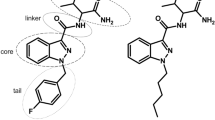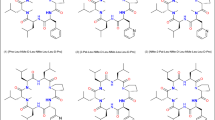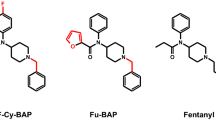Abstract
Purpose. To evaluate the chemical and enzymatic stability, as well as the cellular permeation characteristics, of the acyloxyalkoxy-based cyclic prodrugs \(\underset{\raise0.3em\hbox{$\smash{\scriptscriptstyle-}$}}{1} \) and \(\underset{\raise0.3em\hbox{$\smash{\scriptscriptstyle-}$}}{2} \) of the opioid peptides [Leu5]-enkephalin (H-Tyr-Gly-Gly-Phe-Leu-OH) and DADLE (H-Tyr-D-Ala-Gly-Phe-D-Leu-OH), respectively.
Methods. The rates of conversion of \(\underset{\raise0.3em\hbox{$\smash{\scriptscriptstyle-}$}}{1} \) and \(\underset{\raise0.3em\hbox{$\smash{\scriptscriptstyle-}$}}{2} \) to [Leu5]-enkephalin and DADLE, respectively, were measured by HPLC in HBSS, pH = 7.4, and in various biological media (e.g., human plasma and Caco-2 cell and rat liver homogenates) having measurable esterase activity. The cellular permeation and metabolism characteristics of [Leu5]-enkephalin, DADLE and the cyclic prodrugs \(\underset{\raise0.3em\hbox{$\smash{\scriptscriptstyle-}$}}{1} \) and \(\underset{\raise0.3em\hbox{$\smash{\scriptscriptstyle-}$}}{2} \) were measured using Caco-2 cell monolayers grown onto microporous membranes and monitored by HPLC.
Results. Cyclic prodrugs \(\underset{\raise0.3em\hbox{$\smash{\scriptscriptstyle-}$}}{1} \) and \(\underset{\raise0.3em\hbox{$\smash{\scriptscriptstyle-}$}}{2} \) degraded slowly but stoichiometrically to [Leu5]-enkephalin and DADLE, respectively, in HBSS, pH = 7.4. In homogenates of Caco-2 cells and rat liver, as well as 90% human plasma, the rates of disappearance of the cyclic prodrugs were significantly faster than in HBSS. The stabilities of the cyclic prodrugs \(\underset{\raise0.3em\hbox{$\smash{\scriptscriptstyle-}$}}{1} \) and \(\underset{\raise0.3em\hbox{$\smash{\scriptscriptstyle-}$}}{2} \) were increased significantly in 90% human plasma and Caco-2 cell homogenates when paraoxon, a potent inhibitor of serine-dependent esterases, was included in the incubation mixtures. A similar stabilizing effect of paraoxon was not observed in 50% rat liver homogenates, but was observed in 10% homogenates of rat liver. When applied to the AP side of a Caco-2 cell monolayer, DADLE and cyclic prodrugs \(\underset{\raise0.3em\hbox{$\smash{\scriptscriptstyle-}$}}{1} \) and \(\underset{\raise0.3em\hbox{$\smash{\scriptscriptstyle-}$}}{2} \) exhibited significantly greater stability than [Leu5]-enkephalin. Based on their physicochemical properties (i.e., lipophilicity), cyclic prodrugs \(\underset{\raise0.3em\hbox{$\smash{\scriptscriptstyle-}$}}{1} \) and \(\underset{\raise0.3em\hbox{$\smash{\scriptscriptstyle-}$}}{2} \) should have exhibited high permeation across Caco-2 cell monolayers. Surprisingly, the AP-to-BL apparent permeability coefficients (PApp) for cyclic prodrugs \(\underset{\raise0.3em\hbox{$\smash{\scriptscriptstyle-}$}}{1} \) and \(\underset{\raise0.3em\hbox{$\smash{\scriptscriptstyle-}$}}{2} \) across Caco-2 cell monolayers were significantly lower than the PApp value determined for the metabolically stable opioid peptide DADLE. When the PApp values for cyclic prodrugs \(\underset{\raise0.3em\hbox{$\smash{\scriptscriptstyle-}$}}{1} \) and \(\underset{\raise0.3em\hbox{$\smash{\scriptscriptstyle-}$}}{2} \) crossing Caco-2 cell monolayers in the BL-to-AP direction were determined, they were shown to be 36 and 52 times greater, respectively, than the AP-to-BL values.
Conclusions. Cyclic prodrugs \(\underset{\raise0.3em\hbox{$\smash{\scriptscriptstyle-}$}}{1} \) and \(\underset{\raise0.3em\hbox{$\smash{\scriptscriptstyle-}$}}{2} \) , prepared with an acyloxyalkoxy promoiety, were shown to degrade in biological media (e.g., 90% human plasma) via an esterase-catalyzed pathway. The degradation of cyclic prodrug \(\underset{\raise0.3em\hbox{$\smash{\scriptscriptstyle-}$}}{1} \) , which contained an ester formed with an L-amino acid, degraded more rapidly in esterase-containing media than did prodrug \(\underset{\raise0.3em\hbox{$\smash{\scriptscriptstyle-}$}}{2} \) , which contained an ester formed with a D-amino acid. Cyclic prodrugs \(\underset{\raise0.3em\hbox{$\smash{\scriptscriptstyle-}$}}{1} \) and \(\underset{\raise0.3em\hbox{$\smash{\scriptscriptstyle-}$}}{2} \) showed very low AP-to-BL Caco-2 cell permeability, which did not correlate with their lipophilicities. These low AP-to-BL permeabilities result because of their substrate activity for apically polarized efflux systems.
Similar content being viewed by others
REFERENCES
B. Wang, K. Nimkar, W. Wang, H. Zhong, D. Shen, O. S. Gudmundsson, S. Gangwar, T. J. Siahaan, and R. T. Borchardt. Synthesis and evaluation of the physicochemical properties of esterase-sensitive cyclic prodrugs of opioid peptides using phenylpropionic acid and coumarinic acid linkers. J. Peptide Res. (in press).
O. S. Gudmundsson, G. M. Pauletti, W. Wang, D. Shan, H. Zhang, B. Wang, and R. T. Borchardt. Coumarinic acid-based cyclic prodrugs of opioid peptides that exhibit metabolic stability to peptidases and excellent cellular permeability. Pharm. Res. 16:7–15 (1999).
O. S. Gudmundsson, K. Nimkar, S. Gangwar, T. J. Siahaan, and R. T. Borchardt. Phenylpropionic acid-based cyclic prodrugs of opioid peptides that exhibit metabolic stability to peptidases and excellent cellular permeability, Pharm. Res. 16:16–23 (1999).
S. Gangwar, G. M. Pauletti, T. J. Siahaan, V. J. Stella, and R. T. Borchardt. Synthesis of a novel esterase-sensitive cyclic prodrug of a hexapeptide using an acyloxyalkoxy promoiety. J. Org. Chem. 62:1356–1362 (1997).
G. M. Pauletti, S. Gangwar, F. W. Okumu, T. J. Siahaan, V. J. Stella, and R. T. Borchardt. Esterase-sensitive cyclic prodrugs of peptides: evaluation of an acyloxyalkoxy promoiety in a model hexapeptide. Pharm. Res. 13:1615–1623 (1996).
S. Gangwar, S. D. S. Jois, T. J. Siahaan, D. G. Vander Velde, V. J. Stella, and R. T. Borchardt. The effect of conformation on membrane permeability of an acyloxyalkoxy-linked cyclic prodrug of a model peptide. Pharm. Res. 13:1657–1661 (1996).
A. Bak, T. J. Siahaan, O. J. Gudmundsson, S. Gangwar, G. J. Friis, and R. T. Borchardt. Synthesis and evaluation of the physicochemical properties of esterase-sensitive cyclic prodrugs of opioid peptides using an (acyloxy)alkoxy linker. J. Peptide Res. (in press).
I. J. Hidalgo, T. J. Raub, and R. T. Borchardt. Characterization of the human colon carcinoma cell line (Caco-2) as a model system for intestinal epithelial permeability. Gastroenterology 96:736–740 (1989).
J. Hughes, Centrally acting peptides; University Park Press, Baltimore, MD, 1977.
J. M. Hambrook, B. A. Morgan, M. J. Rance, and C. F. C. Smith. Mode of deactivation of the enkephalins by rat and human plasma and rat brain homogenates. Nature 262:782–783 (1976).
R. Oliyai. Prodrugs of peptides and peptidomimetics for improved formulation and delivery. Adv. Drug Del. Rev. 19:275–286 (1996).
H. Bundgaard. Means to enhance penetration. Prodrugs as a means to improve the delivery of peptide drugs. Adv. Drug Del. Rev. 8:1–38 (1992).
S. Gangwar, G. M. Pauletti, B. Wang, T. J. Siahaan, V. J. Stella, and R. T. Borchardt. Prodrug strategies to enhance the intestinal absorption of peptides. Drug Discovery Today 2:148–155 (1997).
C. H. Walker and M. I. Mackness. “A” esterases and their role in regulating the toxicity of organophosphates. Arch. Toxicol. 60:30–33 (1987).
T. L. Huang, T. Shiotsuki, T. Uematsu, B. Borhan, Q. X. Li, and B. D. Hammock. Structure-activity relationships for substrates and inhibitors of mammalian liver microsomal carboxylesterases. Pharm. Res. 13:1495–1499 (1996).
K. Takahashi, S. Tamagawa, H. Sakano, T. Katagi, and N. Mizuno. Effects on the ester moiety on stereoselective hydrolysis of several propranolol prodrugs in rat tissue. Biol. Pharm. Bull. 18:1401–1404 (1995).
P. S. Burton, J. T. Goodwin, R. A. Conradi, N. F. H. Ho, and A. R. Hilgers. In vitro permeability of peptidomimetic drugs: The role of polarized efflux pathways as additional barriers to absorption. Adv. Drug Del. Rev. 23:143–156 (1997).
O. S. Gudmundsson, S. D. S. Jois, D. G. Vander Velde, T. J. Siahaan, B. Wang, and R. T. Borchardt. The effect of conformation on the membrane permeability of coumarinic acid-and phenylpropionic acid-based cyclic prodrugs of opioid peptides. J. Peptide Res. (in press).
O. S. Gudmundsson, D. G. Vander Velde, S. D. S. Jois, A. Bak, T. J. Siahaan, and R. T. Borchardt. The effect of conformation on the membrane permeability of acyloxyalkoxy-based cyclic prodrugs of opioid peptides. J. Peptide Res. (in press).
Author information
Authors and Affiliations
Corresponding author
Rights and permissions
About this article
Cite this article
Bak, A., Gudmundsson, O.S., Friis, G.J. et al. Acyloxyalkoxy-Based Cyclic Prodrugs of Opioid Peptides: Evaluation of the Chemical and Enzymatic Stability as Well as Their Transport Properties Across Caco-2 Cell Monolayers. Pharm Res 16, 24–29 (1999). https://doi.org/10.1023/A:1018854308829
Issue Date:
DOI: https://doi.org/10.1023/A:1018854308829




